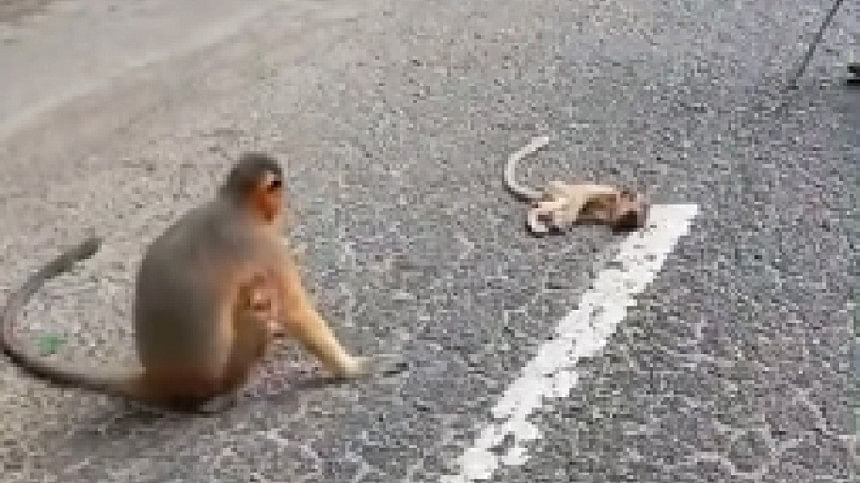Speeding vehicles turn forest road into death trap

In a tragic incident on May 20, an endangered Capped Langur baby was crushed to death by a speeding microbus on the old Dhaka-Sylhet highway through Satchari National Park.
The mother langur was seen sitting beside her dead offspring for hours -- a sight that deeply moved commuters and locals alike.
Forest officials have yet to identify the vehicle responsible.
With the highway passing directly through the forest in Chunarughat upazila of Habiganj, such incidents are common, said Miftaul Islam, a local.
There are regular reports of endangered Capped Langurs, snakes, barking deer, and other animals being killed due to unchecked vehicle movement on the road.
Countless animals are at risk due to vehicular traffic through the 600-acre forest, a biodiversity hotspot and home to 197 species of animals, reptiles and birds, including several endangered species. Primates, in particular, are highly vulnerable as they often roam near the roads.
Conservationists and locals have repeatedly urged authorities to adopt urgent measures, including speed control, better signage, stricter vigilance and enforcement of rules, to prevent further loss of animal lives in this ecologically sensitive area.
Sand- and stone-laden heavy trucks often pass through the forest at reckless speeds, exceeding the designated 20kmph limit.
"Some 10-12 wild animals die every month on this road," claimed Mobin Mia, a local.
"All other roads in Satchari are in a sorry state except this one, which connects to the main Dhaka-Sylhet highway via Jagadishpur Muktijoddha Chattar in Madhabpur upazila of Habiganj. As such, drivers often opt to use this road and drive at high speed," said Saddam Hosain, a car driver.
Tofazzal Sohel, general secretary of Bangladesh Poribesh Andolon's Habiganj unit, said there are not enough road signs to warn drivers, and few adhere to speed limits.
Shoeb Chowdhury, former president of Habiganj Press Club, called for coordination between the Forest Department and Roads and Highways Department, including forming a joint taskforce to plan and monitor protective steps, as well as public awareness campaigns to build empathy among drivers, and maintaining a database of roadkill incidents to guide policy measures.
Contacted, Dr Jahangir Alam, divisional forest officer in Sylhet, said, "While we don't have an exact figure, it's true that many animals are dying due to speeding vehicles."
"Unfortunately, current laws under the Road Transport Act do not permit construction of speed breakers, thereby making it difficult to mitigate such incidents," he also said.
"We are looking into potential solutions and will consult with environmental experts and the environment adviser to explore what can be done within legal frameworks," the DFO added.
Zakir Hosain, executive engineer of Roads and Highways in Habiganj, said, "We have installed signs in the forest area, encouraging drivers to slow down and avoid honking."
"While we do have specific policies regarding installation of speed breakers, the Forest Department has not formally consulted or communicated with us on this matter. If they reach out, we will certainly look into it."

 For all latest news, follow The Daily Star's Google News channel.
For all latest news, follow The Daily Star's Google News channel. 



Comments